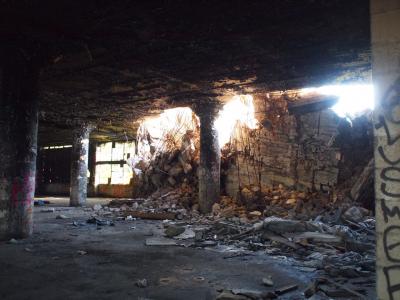By SAHIBA GILL
1.
When I read the list of companies who owned the now-ruined clothing factory in Dhaka, Bangladesh—New Wave Bottoms, New Wave Style, Ether Tex, Phantom Tec—I thought about my walks in Abu Dhabi, which have been driven from the start by following the bright spool of electric shop names wrapping around each block. It’s not so much the city lights that pull me out there as their measurement of my distance from home, conveyed not in watts but in the degree of mistranslation. On the Los Angles Boutique is a neon image of the Golden Gate Bridge; above a cramped snack stand reads “Chamsely See Coffee Shop (think: Champs Élysées). When TIME Magazine published the list of retailers buying from the collapsed factory and asked “Is there blood on your shirt?” readers suspected the answer might be yes. I wondered not only about my own shirts but also about the ball gowns of Cincinnati Fashion Design on Abu Dhabi’s Airport Road.
Dhaka’s Rana Plaza building, which collapsed on April 24, held five garment factories. After four days, most factory workers were dead, except one woman trapped behind a fallen pillar, almost rescued until the sparks from an electric grinder set the clothes surrounding her on fire, and she died of smoke inhalation. At this point, all hope is gone, and yet the death toll rises because workers keep finding bodies – a total of 1,129 at the end of May. Rana Plaza collapsed from cracks that appeared in its structure on April 23. When the building buckled, concrete beams rained down on those trapped in the stories below. As rescuers now sort through the shreds, they bring up charred and bloodied fabric scraps to record the names of the brands that kept the factory in business. April’s calamity was not the only source of bleeding in Bangladesh’s factories. Last November, a fire at the Tazreen Fashion Factory in Dhaka left 200 garment workers injured and 117 dead.
 2.
2.
Bangladesh is the world’s second-largest clothing mill—second, by virtue of scale, to China. The European Union is the heaviest consumer of Bangladeshi ready-made garments, or RMGs, and the United States is the second, importing half the volume Europe does. Along with Canada, they carry an estimated 81% of the RMG industry in Bangladesh, itself a full 12% of the country’s GDP.
The industry began small in 1979, in a single joint venture by Desh Garments with a Korean manufacturer, Daewoo. By 1985, 700 Bangladeshi factories were exporting to the US and Europe under the quota system regulated by the WTO, which protected countries’ domestic garment industries from being undercut by international competition from lowest-price bidders.In 2005, when the WTO phased out all import quotas on RMGs, Bangladesh’s garment industry was expected to decline, outbid by industrial powerhouse China.
But Bangladesh is primed for low-cost manufacturing. In population, Bangladesh ranks 8th in the world, before Egypt and Germany. In GDP, it ranks 58th, just edging out Angola. During the past seven years, the country’s GDP has almost doubled, and the boom has brought an estimated one-quarter to one-half million rural Bangladeshis to Dhaka and its outskirts, where garment factories offer steady and relatively high pay. According to the UN, Dhaka has the second-highest growth rate of any city in the world.
3.
Across Asia, the exodus from countryside to city is driving the headlines, from which novelist Mohsin Hamid borrows the title of his new novel, How to Get Filthy Rich in Rising Asia. The book, satirically styled as a self-help guide, begins with the caveat that the latter genre is by definition self-diminishing, relinquishing autonomy to a system of thought written by someone else.
In the novel, the system of self-help is Rising Asia, and the characters, addressed as “you,” find their way more by luck than by volition, making the notion of a self exceptionally “slippery.” Your chance at school is a function of your status as the second son, neither married off like your sister nor sent to work like your elder brother. As an adult, your fortunes in business are determined by the bottled water company’s henchmen, who keep your rise slow at pain of violent death, then – when you have finally made it – by their financial goons, who force you into a stark choice of acquisition or leveraged expansion. You choose the latter, but you also suffer a heart attack, during which your brother-in-law steals away to America, leaving you with a pile of debt.
Despite the recommendation to “have an exit strategy,” you are powerless to exit on your own terms. In the end, you die, with nothing to your name. The only time you ever did make a choice was at the outset of your story when, dying of Hepatitis E, you told your parents you were strong enough to move to the city. It is a kick or be-kicked world, and you suffer your fortune is to suffer blows later on than others.
Mohammed Sohel Rana, the businessman who owned the Rana Plaza factory, might have read the how-to guide that made you so rich. Rana too came from a poor family and rose to power through student politics. In 2008, when a friend became a member of parliament, Rana became head of the Jubo League, the ruling party’s youth wing. Protected from the law by his connections, Rana forcibly grabbed land in Sarvar, an industrial suburb of Dhaka, and began to build garment factories, bribing local government to get the state license. Both you and Rana are reckless with life and death, so long as it is not your own. You sell boiled water in re-sealed plastic bottles, exposing customers to the same water-borne diseases that almost killed you as a child. Similarly, on the day of the collapse, Rana forced workers to their machines despite a police order to close the building after an engineer pointed out the exterior buckling.
Then, for as high you rose, both you and Rana fell within a single day. Rana was arrested by Bangladeshi police after trying to flee into India.
4.
Before their own countries had such cities of industry, South Asians moving from the country to the city in South Asia came here, to Abu Dhabi. They still do, to fill construction jobs supplied by the city’s ever-growing skyline. There has been no mass death here, as in Bangladesh, but there are smaller hurts: absconded passports, withheld wages, debtors prison. As I walk the streets lined with clothing stores, I pass rows of men hunched on the curb, eating fried snacks from rolled newspaper with their ears to small phones. Like Dhaka, this city relies on a single precious export. Oil may be more expensive, but perhaps not more ubiquitous than RMGs. I have five shirts made in Bangladesh. Do they have blood on them?
On my walk home, I stop at Cincinnati Fashion Design, whose familiar letters naming a place I know well from being raised in Ohio I first spotted from a taxi window. In the shop window, mannequins wear ball gowns. The dresses are formal – shoulders left bare, skirts stiff with tulle – and western (not abaya, jilbab, orsari). Though there are Cincinnatis in Arkansas, California, Indiana, and Iowa, Ohio’s was the first (named for the Society of Cincinnati, for Cincinnatus, a Roman general of famed civic virtue) and is the probable inspiration for the store. And a strange inspiration, too, because Cincinnati, which shares zip codes with Kentucky, is always behind the times – twenty years, if you believe Mark Twain. And so are these dresses. They are flouncy. The skirts – while stiff – are also ruffled. The shoulders may be exposed, but they are edged with dense lace and rhinestones on princess collars and sleeves.
After a moment, I realize that halfway across the world Cincinnati high schoolers wear prom dresses that look eerily similar to the ones in this shop window. Abu Dhabi’s Cincinnati Fashion Design has unwittingly produced a perfect replica of real Cincinnati fashions here in the Persian Gulf.
In a way, being Filthy Rich in Dhaka is like being an Ohioan in Abu Dhabi. Where I wedge ironic spaces between the intended and actual meanings of clumsily translated shop names, you remorselessly pry open bureaucratic regulations to make your fortune.
5.
In the weeks after the collapse, while rescue workers exhumed corpses from the rubble, American and European retailers struggled with how to prevent another Rana Plaza-like collapse. By mid-May, all major European retailers – H&M, Inditex (owner of Zara), Marks and Spencer, Tesco, Primark, Carrefour, and Benetton, among others – agreed to the Accord on Fire and Building Safety in Bangladesh (American companies agreed last week to a separate, smaller set of reforms, run by a D.C. think tank). The five-year agreement requires these companies to conduct independent safety inspections and remediation at the majority of its factories and will be administered by a committee with equal labor and corporate representation. Within the past month, the Bangladeshi cabinet has also lifted barriers to organizing unions without factory owners’ approval, created a pension fund for garment workers, and established a wage board to discuss increasing the industry minimum wage, 20 cents per hour. It is a change for a country whose labor regime has been reported to treat factory owners with kid gloves while pursuing allegedly spurious legal action against labor leaders. If the landmark Accord is a success, then Bangladesh will have enacted its own program of what Hamid’s desperate, striving narrator might recognize as self-help.
Given the current system of glibly evanescent perpetrators, I can likely never know whether there’s blood on my shirt. It also seems I don’t anymore know what counts as clumsy translation. Phantom Tec – for a company owned by the Filthy Rich of Rising Asia – is a masterfully prophetic name.
Sahiba Gill is Assistant Editor at The Common and a Global Academic Fellow at NYU Abu Dhabi.



